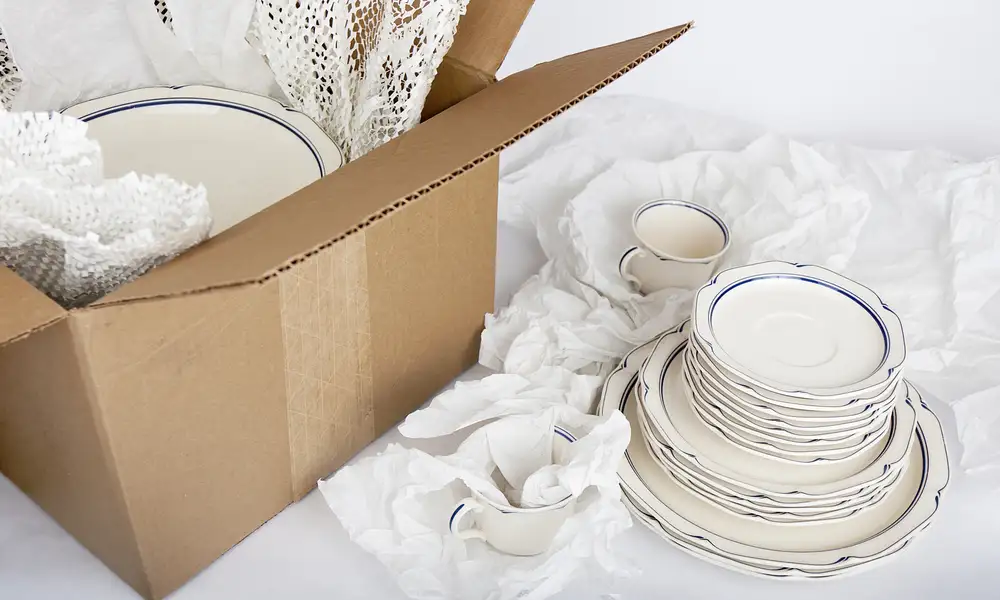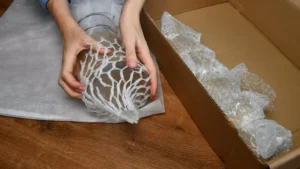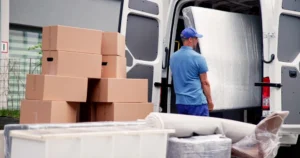Moving day brings many challenges, but packing delicate dishware often creates the most anxiety. That distinct clink of dishes shifting can send shivers down any mover’s spine. Learning how to pack dishware properly prevents breakage and protects your investment. Broken dishes mean wasted money, lost memories, and replacing essentials before you’ve unpacked. The right techniques make the difference between intact dishware and shattered pieces.
This guide covers the entire process from gathering materials to organizing boxes. You’ll learn techniques for protecting everything from mugs to serving platters, plus space-saving tips and common mistakes to avoid. Good news: packing dishware doesn’t have to be complicated, just methodical.
Packing Materials Needed

Essential Supplies
The foundation of safe dishware packing starts with the right materials:
- Moving boxes: Dish pack boxes with double-thick walls offer superior protection compared to regular moving boxes, though standard medium boxes work well for lighter loads.
- Packing paper: Unprinted newsprint is ideal because it won’t transfer ink onto your dishes.
- Bubble wrap: Adds extra cushioning for particularly fragile items like crystal or fine china.
- Packing tape: Heavy-duty tape ensures boxes stay securely sealed during transport.
- Markers for labeling: Permanent markers help you identify each box clearly for easy unpacking.
Optional but Helpful Materials
- Dish dividers or cell kits: Create individual compartments within boxes, drastically reducing movement during transit.
- Foam pouches: Provide ready-made protection for individual pieces.
- Old newspapers: A budget-friendly option, though they may leave ink residue on dishes.
- Clean towels or linens: Serve double duty by padding dishes while getting transported anyway.
- Styrofoam peanuts: Fill empty spaces and prevent shifting inside boxes.
How to Pack Dishware for Moving in Five Easy Steps
Following a systematic approach makes packing dishware straightforward and efficient. These five steps will guide you through the entire process, from preparation to the final seal, ensuring your dishes arrive safely at your new home.
Step 1: Prepare Your Workspace and Materials
Start by setting yourself up for success. Clear a large, flat surface like a dining table or kitchen counter where you can work comfortably. Gather all your packing materials within arm’s reach to maintain an efficient workflow. Sort your dishware by type and fragility level—group plates together, bowls together, and identify which pieces need extra care. Before packing anything, ensure all items are clean and completely dry, as moisture can lead to mildew or damage during storage.
Step 2: Reinforce and Cushion Your Boxes
Box preparation is crucial for preventing breakage. Choose appropriately sized boxes, remembering that smaller boxes work better for heavy dishware to prevent overloading. Reinforce the bottom using the H-taping method by running tape along the seam, then adding perpendicular strips across it. Create a cushioning layer three to four inches thick at the bottom using crumpled packing paper or bubble wrap. This foundation absorbs shock and prevents items from hitting the box bottom during transport.
Step 3: Wrap Each Item Individually
Protection starts with proper wrapping technique. For plates, place each one in the center of packing paper, fold corners over, and stack no more than four to five wrapped plates together before wrapping the bundle again. Bowls should be wrapped individually, with smaller bowls nested inside larger ones only after each is wrapped. Serving platters require extra attention due to their size and often irregular shapes wrap them flat with multiple layers. Valuable or antique pieces deserve double-wrapping with both paper and bubble wrap for maximum protection.
Step 4: Pack Strategically in the Box
Strategic placement prevents shifting and breakage. Place your heaviest items like dinner plates on the bottom, standing on edge rather than flat when possible, as edges are stronger than faces. Medium-weight items like bowls go in the middle layer. Reserve the top section for your lightest pieces such as saucers and small bowls. Fill every empty space with crumpled packing paper to prevent movement. Perform the “no rattle” test by gently shaking the box—if you hear items moving, add more padding.
Step 5: Seal and Label Properly
Proper sealing ensures everything stays secure. Use heavy-duty packing tape to seal the top using the same H-taping method you used on the bottom. Clearly label each box as “FRAGILE” and “THIS SIDE UP” on multiple sides so handlers can see warnings from any angle. Mark which room the box belongs to for easier unpacking. Consider creating an inventory list of contents for each box, which helps when you need specific items and makes insurance claims easier if damage occurs.
You may read How To Pack Dishes For Moving Without Paper?
How to Pack Cups and Glasses
Learn how to pack cups and glasses safely using proper wrapping and cushioning to prevent chips or cracks. Follow simple steps to keep every piece secure.
Special Considerations for Glassware
Cups and glasses demand different techniques than plates due to their hollow structure and vulnerable rims. Stemware presents unique challenges with delicate stems that break easily under pressure, while regular drinking glasses are sturdier but still prone to chipping. Temperature-sensitive materials like crystal require extra care, as extreme temperature changes during transport can cause cracking.
Step-by-Step Packing Process
Begin by stuffing the inside of each glass with crumpled packing paper to provide internal support and prevent crushing. Wrap each piece individually, starting from the base and working upward, ensuring the rim receives extra padding. Pack glasses upright in boxes rather than on their sides, as rims are stronger than bodies and can better support weight. Dish dividers create protective compartments that prevent glasses from touching each other during transit.
Wine Glasses and Stemware
Stems are the weakest point and need special attention. Wrap extra padding around stems before wrapping the entire glass, or use pre-formed dividers specifically designed for stemware. Consider investing in specialized wine glass boxes with individual cells for valuable collections. Champagne flutes, with their tall, narrow design, should be wrapped individually and packed upright with substantial padding between each piece.
Coffee Mugs
Handles are surprisingly fragile and require careful attention. Wrap additional paper around handles before wrapping the entire mug. Similar-sized mugs can be nested together only when each is individually wrapped first, saving space without compromising protection. Ceramic mugs are generally more durable than porcelain, but both need proper cushioning to prevent chips and cracks at vulnerable points like handles and rims.
Pro Tips for Packing Different Types of Dishware
Not all dishware requires the same level of protection, and understanding these differences saves time and materials. Tailoring your approach based on value, fragility, and shape ensures efficient packing without compromising safety.
Fine China and Antiques
Heirloom china and antique pieces demand maximum protection when packing dishes in boxes. Use at least three layers of wrapping material packing paper, bubble wrap, and another paper layer to create a protective cocoon. Extremely valuable pieces deserve individual boxing rather than mixing them with other items, eliminating any risk of contact damage. Consider documenting your collection with photos and appraisals before moving, and check whether your homeowner’s or renter’s insurance covers the full value during transit, or if additional moving insurance is necessary.
Everyday Dishware
When packing plates for moving that see daily use, you can streamline the process without sacrificing safety. Wrap plates in bundles of three to four instead of individually, which saves time and materials. For durable stoneware or basic ceramic pieces, a single layer of packing paper often suffices. Focus your energy on proper box cushioning and strategic placement rather than elaborate wrapping for these workhorse pieces.
Special Items
Packing kitchen items with unusual shapes requires creative problem-solving. Large serving bowls and oval platters should be wrapped generously and positioned flat or on edge, never at angles that stress their structure. Small items like gravy boats, creamers, and salt and pepper shakers can be wrapped individually then grouped together in a single bundle, filling gaps in larger boxes. Decorative pieces with protruding elements need extra padding around vulnerable areas wrap these extensions separately before wrapping the entire piece to prevent breakage at attachment points.
When to Call Professionals
As a trusted Sherman Oaks Packing Company, we bring expert care and precision to packing delicate dishware. We use professional-grade materials and offer full insurance coverage for your peace of mind. What may take you days, we complete in hours saving you time and effort. Our team specializes in handling fine china, antiques, and valuable collections with custom crating for extra protection. Whether you need full-service packing or help with your most fragile items, we ensure everything arrives safely. Choose Chamomile Go for reliable and professional packing services in Sherman Oaks.
Conclusion
In conclusion, following the five-step process sorting, wrapping, cushioning, boxing, and labeling helps protect your dishware during the move. Take your time and use the right packing materials to avoid chips or cracks. Proper packing ensures your dishes arrive safely and ready for your new kitchen. If you’re short on time or handling valuable pieces, professional help is worth it. Start gathering your supplies or contact Chamomile Go, your trusted Sherman Oaks Packing Company, to schedule expert packing services today.
FAQs
What Is The Best Way To Pack Dishes For Moving?
The best way to pack dishes is to wrap each piece individually with packing paper or bubble wrap, place them vertically in sturdy boxes with cushioning, and fill empty spaces to prevent shifting during transit. Label each box as “Fragile” for extra care.
What Packing Materials Do I Need To Pack Dishware Safely?
You’ll need sturdy moving boxes, packing paper, bubble wrap, dish dividers, and packing tape. Avoid using newspaper since ink can transfer onto your dishes. A dish pack box or cell kit is ideal for fragile items.
How Do I Pack Plates To Avoid Breaking Them?
Wrap each plate separately with packing paper or bubble wrap, and stack them vertically (like records) instead of flat. Add padding at the bottom and top of the box for shock absorption.
How Do I Pack Glasses And Cups For Moving?
Wrap each glass or cup in packing paper, stuff the inside with paper for extra support, and place them upright in a divided box. Use plenty of cushioning around them to prevent movement.
Should I Use Bubble Wrap Or Packing Paper For Dishes?
Both work well use packing paper for general protection and bubble wrap for extra-fragile or valuable dishware. Layering both offers the best protection during long-distance moves.








